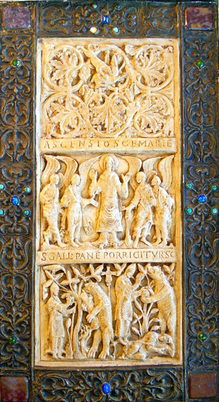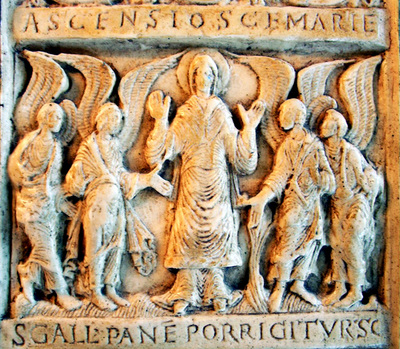Graphic Arts holds a small collection of sample bindings and sewing structures, which includes this facsimile of a Carolingian carved ivory book cover.
“According to a monastic writer at St Gall, the ivories with the Virgin and St Gall were carved by the monk Tuotilo, whose artistic interests apparently included book illumination and music. The beautifully carved vines, with a lion attacking a bull, almost exactly reproduce another ivory in the St Gall collection, and a recent book suggests that both ivories came to St. Gall from the court of Charlemagne, but with one pair remaining blank until carved by Tuotilo.”—Lawrence Nees, Early Medieval Art (2002) Marquand N5970 .N44 2002
James Midgley Clark points out that the most interesting items at the St Gall Abbey in Switzerland are the ivory tablets attributed to Tuotilo. “They form the cover of the famous Evangelium Longum. Both tablets are enclosed in a frame of gilded silver with precious stones. … The second tablet depicts a fight between animals, surrounded by foliage, the assumption of the Virgin Mary, two scenes from the life of St Gall with the inscription: S. Gallus panem porrigit urso [St Gall gives bread to the bear].”
“There is a striking resemblance between the decorative foliage of this tablet and the designs on a small ivory relief which serves as the cover of Codex No. 60. The subject depicted here is lions and panthers attacking a bull and a hind. The upper cover consists of skillfully carved but plain rosettes. That Tuotilo was a historical personage is an indisputable fact; after his death he was reversed as a saint and a chapel in the Abbey Church was named after him, from which we may conclude that he was one of the outstanding personalities of his day.” —The Abbey of St Gall as a Centre of Literature and Art (1926). (F) DQ549.4 .C6 1926
To see a digital image of the original, see: http://tinyurl.com/tuotilo



